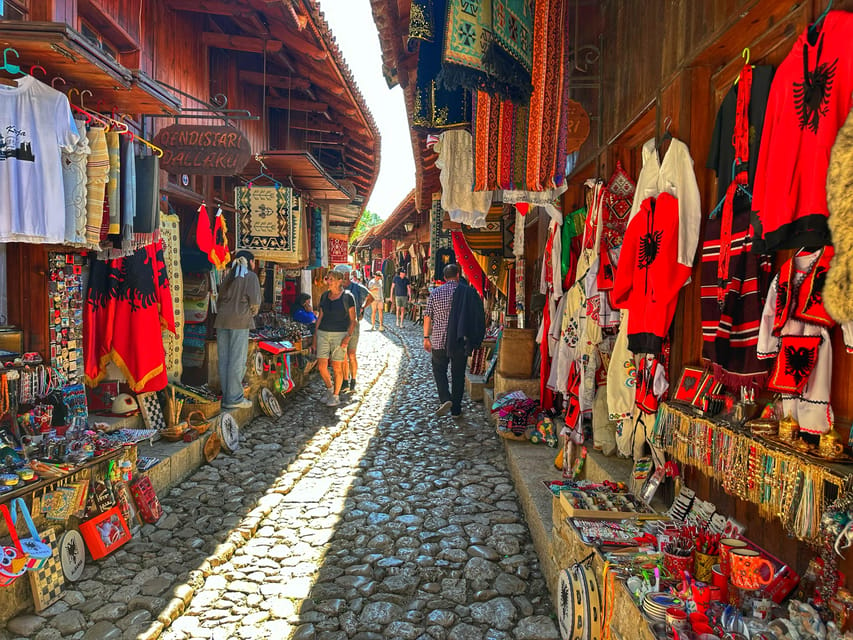
Key Takeaways
- Kruja Bazaar is a living museum reflecting Albania’s rich history and culture.
- Its origins date back to the Ottoman period, playing a vital role in regional trade and defense, especially during Skanderbeg’s time.
- The scenic location on Mount Kruja offers breathtaking views of mountains, valleys, and the nearby Adriatic Sea.
- The vibrant market atmosphere features narrow, cobbled streets and traditional wooden *dukan* shops selling crafts and local products.
- Visitors can experience authentic Albanian crafts, taste local cuisine like *byrek* and *tave kosi*, and engage with friendly artisans.
- Tips include visiting during spring or fall, using public transport from Tirana, bargaining politely, and learning basic Albanian phrases.
- Today, Kruja Bazaar significantly contributes to preservation of culture and the local economy through tourism and artisan support.
Table of contents
- Historical Background of Kruja Bazaar: Unveiling Its Rich Past
- Location and Setting: Embracing the Scenic Surroundings
- Features and Atmosphere of Kruja Bazaar: A Vibrant Traditional Market
- Things to See and Do at Kruja Bazaar: Engaging Experiences Await
- Visiting Tips: Enhance Your Kruja Bazaar Experience
- Importance of Kruja Bazaar Today: Cultural Heritage and Economic Impact
- Conclusion: Why Kruja Bazaar is a Must-Visit Spot for Travelers
Historical Background of Kruja Bazaar: Unveiling Its Rich Past
*Kruja Bazaar* traces its roots back to the Ottoman era, when it emerged as a crucial trade hub in the Balkans. Historically, it was a vital link for merchants across Albania and beyond, serving as a thriving center for commerce and social exchange.
During the 15th century, the bazaar flourished further, becoming intimately connected with Skanderbeg, Albania’s legendary national hero. Kruja was his stronghold, where he passionately defended the land against the Ottoman Empire. The bazaar was active during this period, facilitating supplies, communication, and troop movement, playing a pivotal role in national resistance.
In medieval times, Kruja Bazaar was renowned for its craftsmanship, bustling trade, and agricultural produce, weaving a legacy of artistry and commerce that continues today. Its collection of artifacts and stories from these vibrant periods makes it an invaluable destination for history lovers and cultural explorers.
[Source: Studies on Albanian History]
Location and Setting: Embracing the Scenic Surroundings
*Nestled* in central Albania, approximately 20 km northeast of Tirana, Kruja Bazaar offers a breathtaking natural setting. Located on the slopes of Mount Kruja, it provides stunning panoramic views that captivate visitors.
The landscape around Kruja is a picturesque blend of rugged mountains, lush valleys, and distant glimpses of the Adriatic Sea. The natural beauty enhances the charm of the bazaar and invites visitors to explore scenic trails and vistas.
Accessibility from Tirana makes it an ideal day-trip destination. The short, scenic drive rewards visitors with a retreat immersed in nature, history, and authentic Albanian culture, making Kruja an irresistible travel spot.
Features and Atmosphere of Kruja Bazaar: A Vibrant Traditional Market
The atmosphere in Kruja Bazaar is a captivating mix of tradition and vibrant energy. Its layout features narrow cobblestone streets lined with quaint wooden *dukan* shops, each offering a glimpse into local life.
Walking through these winding lanes feels like stepping back in time, surrounded by authentic sights and sounds. The market is famous for its handcrafted Albanian arts—intricate carpets, traditional clothing with vibrant patterns, and wooden carvings. Local products such as honey and olive oil showcase the region’s agricultural bounty.
The lively ambiance is filled with vendor chatter, traditional music, and tempting aromas of local foods. Interacting with vendors creates a warm, welcoming environment, offering an immersive experience into Albanian culture.
Things to See and Do at Kruja Bazaar: Engaging Experiences Await
Lovers of crafts and culture will find plenty to explore at Kruja Bazaar. Shop for handmade carpets, silver jewelry, and traditional accessories that embody Albanian artistry.
Food lovers can indulge in local dishes like *byrek*, a savory pastry, and *tave kosi*, baked lamb with yogurt. Don’t miss sampling traditional beverages like strong Albanian coffee or *raki*, a fruit brandy with a storied history.
Engagement with artisans enriches the visit—many are eager to share stories about their crafts and demonstrate techniques, offering a meaningful connection to Albanian cultural traditions. It’s an interactive experience that leaves visitors with lasting memories.
Visiting Tips: Enhance Your Kruja Bazaar Experience
For a memorable visit, consider traveling during spring (April to June) or fall (September to October) for mild weather and fewer crowds.
Getting to Kruja from Tirana is easy: regional buses depart regularly from the Tirana bus terminal, or you can hire a taxi for a quicker trip. Bargain politely—haggling is a cultural norm and can add to the fun of shopping.
To foster genuine interactions, learn a few basic Albanian phrases like *Përshëndetje* (Hello) and *Faleminderit* (Thank you). Respect for local customs will enhance your experience and create friendly exchanges.
Importance of Kruja Bazaar Today: Cultural Heritage and Economic Impact
Today, Kruja Bazaar plays a vital role in preserving Albanian heritage. It functions as a living museum, safeguarding traditional crafts, stories, and skills of artisans. Supporting these crafts encourages cultural continuity and keeps history alive.
Economically, the bazaar attracts thousands of visitors annually, contributing significantly to local businesses. Tourists spend on shopping, dining, and accommodations, providing essential revenue streams. Artisans benefit directly, ensuring sustainable livelihoods and encouraging the growth of traditional industries.
This dual role as a cultural guardian and economic driver makes Kruja Bazaar an essential pillar of regional identity and development.
Conclusion: Why Kruja Bazaar is a Must-Visit Spot for Travelers
In summary, Kruja Bazaar offers an exceptional journey into Albanian history, culture, and scenic beauty. Its historical importance, bustling atmosphere, artisanal crafts, and delicious local cuisine make it an unforgettable destination. Visiting Kruja not only enriches your understanding of Albania’s past but also supports its present cultural preservation and economic vitality.
*We encourage every traveler* to add Kruja Bazaar to their list. Experience the vibrant traditions, meet warm-hearted locals, and take home authentic crafts as souvenirs of this remarkable place. Whether exploring its storied past or enjoying its lively present, Kruja Bazaar remains a treasure at the heart of Albania’s cultural landscape.


0 Comment